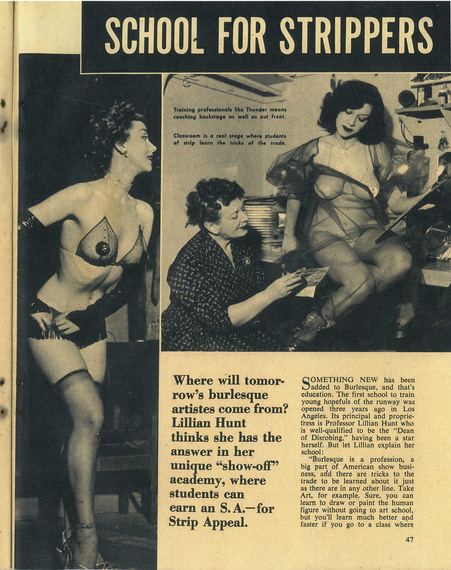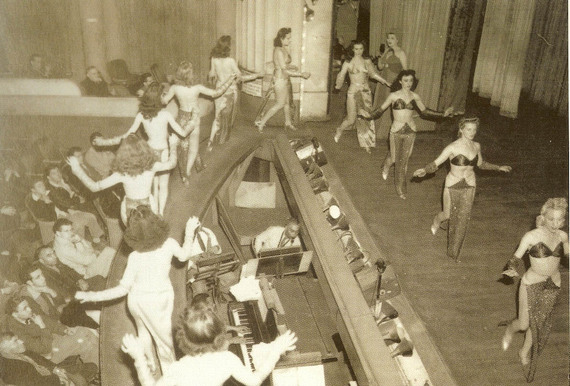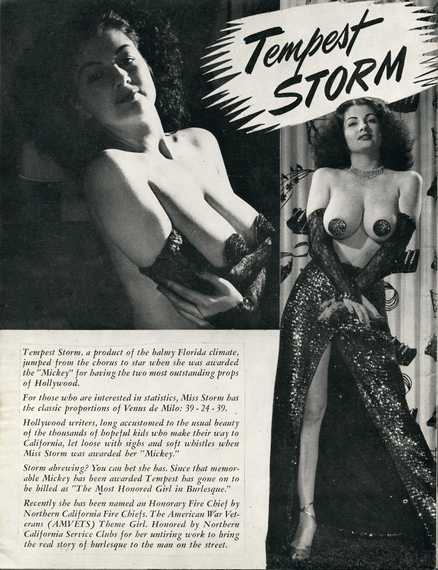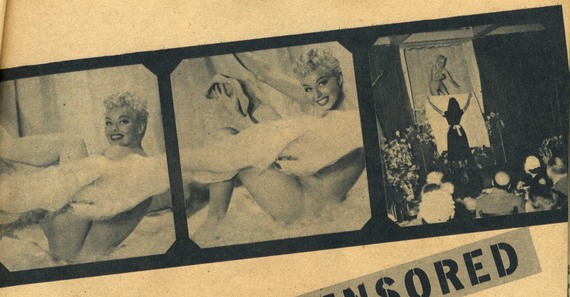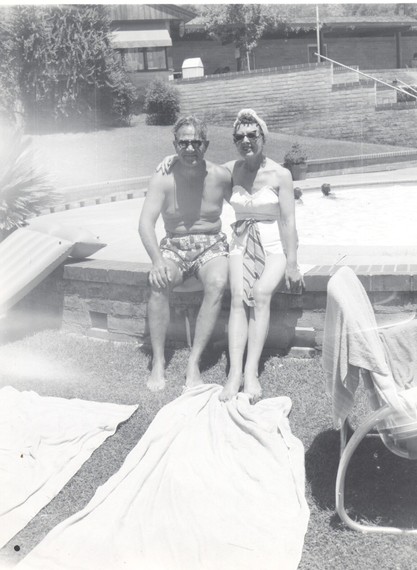She taught them how to walk, when to take it off, how to bump it and "don't forget the grind, which preceded the bump." She ran a school for strippers and her name was Lillian Hunt.
Burlesque bumped its way into the former Belasco Theatre at 337 S. Main Street in downtown Los Angeles in the 1920s. On the outside it wasn't a fancy place. A box office plunked on the street with posters of the curvaceous cuties plastered life-size to entice the passing customers. The lobby wasn't much to look at. The candy butcher had a dingy little room to the side. But inside the theatre was an ornate jewel box with seating for 900. It had a balcony and box seats for the first and upper rows. A runway extended rainbow like between the stage and orchestra pit where 4 black musicians thumped out a bombastic beat while the barely-clad chorus sashayed in circles.
Follies Theatre showing pit and runway (courtesy Bill Counter/Gregory Williams collection)
They say all burlesque theatres smell the same; of sweat, years of moldering dampness and limburger cheese from the comedians' sandwiches. Backstage there was the familiar peeling paint, piled up props and chaotic dressing rooms with g-strings the girls had washed and hung out over the lights to dry. It was glitter and chaos.
And perhaps all burlesque theatres were similar. But the Follies had something none of the other joints had. It had Lillian Hunt.
"Lillian `Hunt'? We used to call her something else," laughed Dixie Evans the Marilyn Monroe of burlesque. I was interviewing Dixie for my book Behind the Burly Q. Dixie had stripped at the Follies and recalled her former employer as being a "bossy thing" who in no uncertain terms "ruled the roost."
Born in 1898 to Russian Jews David and Pearl Izen, she was red-headed Lily Izen. The home was crowded with 6 siblings and maybe that's why Lily left when she was 15 or 16, the same age as a lot of "'her" strippers were when they ran away from home.
Somewhere between a romance with actor George Jensen that left her with a baby daughter and learning to tap dance her way into a chorus line Lily Izen became Lillian Hunt. She married vaudeville comedian Leon DeVoe and the two headed to California.
A big-bosomed, red-headed, blue-eyed woman she was in her mid-forties in 1944 when she landed at the Follies. The Follies was owned by a Robert S. Biggs, some said so his son, Robert Jr. would have access to the girls. Biggs needed someone to run the shows and keep an eye on the goings on backstage. He needed comedians sober and g-strings in place. Hunt took the job.
Lillian wore suits, gloves and hats and "acted" very much the lady, her granddaughter Pepper Aarvold recalled. In a male-dominated burlesque business Hunt wanted to make sure she appeared very much a woman. Not wanting to be thought of as "tough" she almost over "mimicked" lady-like expressions on her face.
Pepper grew up backstage at the Follies sometimes catching the strippers' wardrobes when she wasn't doing her homework in an empty dressing room to the call of the clarinet emanating from the front of the house. Gramps played straight man to the comics.
For nearly 20 years, 7 days a week, 3 shows a day, 4 on Saturdays and Sundays Lillian Hunt, choreographer, producer, director and manager, trained, coached, designed lighting, picked costumes, negotiated salaries, wiped tears, booked acts and kicked stripper ass at the Follies.
Coach, confident and "mom" to the strippers, Lillian Hunt essentially ran a school for strippers. Though her granddaughter assures she would have hated it being called that. She was just doing what she did naturally. Teaching the ABC's of how to be a really fine stripper.
Appearance was everything. Hunt expected her girls to conduct themselves like ladies on stage and off. And while she couldn't keep an eye on them outside the theatre she was vigilant inside her lair. She told her girls to dress in suits and hats and gloves. They were to be dignified.
Bumps weren't everything. She did not want the exotics going for vulgar moves like humping curtains, or rubbing hands over undulating hips, moves that could get one arrested. And did. What was important was the parade. The most successful parade walk was performed by the girls who glided elegantly across the stage using not only their God-given assets but arms and legs and fingers too. For Lillian the parade walk was everything. And she taught the girls to work it.
Counseling the girls in their lives and work Lillian moved about backstage smoking incessantly while not only doling out advice and adjusting a hem, but making sure each girl had something unique to set them apart from each other. A "gimmick" as the song says.
Hunt not only ran the Follies, she also owned a talent agency, Winsor Hunt, booking strippers in nightclubs and theatres around the country earning enough commission that she lived well, had a beautiful apartment and bought herself a new car every two years. In fact, most of her income was earned off commissions, especially when she had a star stripper in her stable.
When an overweight girl with black frizzy hair, beautiful white skin and huge breasts with the name of Annie Blanche Banks walked into her theater Lillian took one look and saw the girl had something sin-sational. According to author Jimmy McDonough in his book Big Bosoms and Square Jaws the "grandmotherly" Lillian told the Georgia cracker to cut out the "men, booze, cigarettes and sweets." Annie lost the weight, straightened her hair, died it a fire engine red and Hunt came up with the moniker to light marquees for decades earning the girl thousands as the newly christened Tempest Storm.
Lillian came up with Storm's particular mode of costume, a sequined gown to her knees with a giant net "lampshade" that hung down giving her the appearance of a swinging bell as she swished and swayed her "money makers" -- her words. With her overblown bust size Tempest didn't need a gimmick. Her impressive 39 inch torpedo-like bust was enough.
Another Hunt favorite was Patti Wagon, before her nose job. "Patti the Co-ed with the Educated Torso" named because the exuberant stripper had gone to college. Patti was athletic and could dance so "Grandma Lily" explained Aarvold placed her on top of a drum on stage swinging her long hair back and forth like a cheerleader. Though not a big star like Storm, she was popular.
Headliner Lili St. Cyr made enormous sums sudsing her long tapers from a tub at the Follies. While she wasn't a client of Hunt's Lillian did occasionally book St. Cyr, once paying her the soap-stopping amount of $10,000 a week in 1952. A tremendous salary for a stripper who didn't even do a traditional strip. She simply bathed.
Hunt and her husband came up with a clever scenario for Lili where she appeared late, rushing into the theatre while the audience grew restless. From the front of the house the nearly 6-foot tall blonde entered laden with shopping bags and instead of making the audience wait further. St. Cyr started her strip as she was, out of her street clothes.
Gilda and her Crowning Glory, aka Shirley Jean Rickert, former Our Gang actress, escaped a "vile" stage mother -- her words -- into the loving care of Hunt and was remembered by Aarvold as being a "down to earth" stripper when she played the Follies with blonde hair cascading down to her waist. 
Gilda years after playing in "Our Gang" (Zemeckis collection)
Stripteaser Gay Dawn was Lillian's "work of art" according to Aarvold. Lillian, not only named her and managed her, she really cared about the Doris Day lookalike who was graceful and the first to peel from atop the giant prop drum on stage.
As her manager Hunt booked Gay Dawn at various theatres and clubs. She was making good money and a name for herself. Variety fortuitously called her "Miss Opportunity." Dawn's boyfriend thought he could do just as well for his lady-love and pocket the commission. He fired Hunt. Lillian was shocked. "It broke Grandma's heart." Up until Gay Dawn Hunt hadn't signed contracts with the girls. She did after that.
Loretta Miller was a not very attractive specialty dancer, she could wrap her leg around her neck on stage. Miller danced for the last time at the Follies wearing a black ribbon in her hair as tribute for a fallen fan. In the early hours of dawn one morning, 26 year old Roger Whittier called the newspapers. He was in the Follies, he explained, where he had broken in and he was armed. He wanted publicity for Miller, whom he had never personally met but of course had seen perform. After the ensuing gun battle with police Whittier lay dead on the Follies stage, clutching Miller's glossies. He had claimed he wanted to get her name in all the papers. He did. But she was fired. Owner Biggs, Sr. explaining, "We don't like this kind of publicity."
Biggs entrusted Lillian to run a tight ship. She kept an eye out for drunkenness and bad behavior once firing a stripper after she bragged too often and too loudly about the amount of sailors she was entertaining back at her apartment.
To newcomer Taffy O'Neil, a naive neophyte stripper with a son stricken with polio at home, Hunt advised that she not "mix with the girls, they'll try and undermine you." Rivalries could be brutal.
O'Neil remembered Leon getting her a drink before a show to quiet her nerves. It did. "I relaxed." Lucky for Taffy alcohol wasn't a problem. For others it was, as drugs too were becoming, especially down in the pit where, as Lillian called one musician sat "a dope fiend." She warned her granddaughter to stay away. Of course it only made him more interesting and Pepper ended up taking a cruise in his custom built car, only to get caught and threatened with expulsion from the Follies. Pepper kept her distance from her sax playing friend without "so much as a `hello'" so her Follies "privileges" would not be revoked.
Drink and drugs weren't the only seedy elements Hunt attempted to shield from her granddaughter. Though men sometimes brought their wives on the weekends, it was generally a raucous men only crowd. Most behaved, though more often than not the candy butcher doubled as a bouncer, removing men with newspapers on their laps that barely covered suspicious activities.
Mostly though burlesque was a decent way to make a living and Hunt wasn't worried about her granddaughter scampering around back stage amongst the pasties and the left over deli wrappers. To Pepper, "I loved the Follies. It was home."
It was relatively safe with vice officers continually in and out, supposedly to check the shows, but often to make friendly with the girls. Same with the fire department boys. Dixie Evans remembered the girls napping downstairs on cots while the vice officers shot the rats scurrying across the pipes in the basement. Their heroes.
Not that there weren't busts at the Follies. In 1947 Lili St. Cyr was found guilty of an indecent performance, arrested and fined $350. Aarvold thought that Marie Voe "forgot" her g-string one night and earned herself an arrest. Another was Betty Rowland who served three weeks in jail, a harrowing time for the red-headed "Ball of Fire" who was close to 40.
What money the Follies made went back into the girls and the comics, while there were still comics. In 1952 the theatre closed, only to take over the Burbank Theatre down the street, reopening as the New Follies.
Lillian was embroiled in many dramas including one brought by Evelyn West. The stripper with the generous bust billed herself as the "$50,000 Treasure Chest." She sued Tempest Storm after Storm began billing herself as the "$50,000 Hollywood Treasure Chest." As her manager, Lillian was hauled into the fracas. In court West won and Tempest dropped the billing.
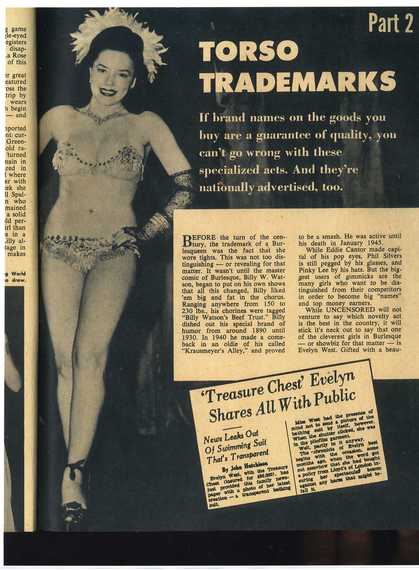
Evelyn West and her "Treasure Chest" (Zemeckis collection)
As burlesque scrambled to keep up with the times the chorus girls and live musicians were the first to be cut. Too expensive. Lillian weathered the changes in the times and the girls.
Except for the Korean War years it became harder to fill the theatre. What had been a big show in the 1930s with a cast of 60, including 30 girls, ground down to 8 chorus girls, 2 comics, 2 straight men, specialty dancers and six strippers. By the 1950s it was impossible to pay the big casts with headliners like Storm and St. Cyr demanding thousands and more cuts were made.
As the straight man on the bill, Hunt's husband DeVoe was told by Biggs he was out. DeVoe was demoted to stagehand. Throughout Hunt scrambled to do the best for her girls as she could, heartbroken to see the chorus axed, her black musicians let go for union whites, until finally they were too expensive and taped music replaced live music altogether.
The type of girls getting into burlesque had changed. Some, like Honey Harlow, Lenny Bruce's girlfriend-wife-ex-wife-all while she stripped, was deep into heroin. Lillian saw it and didn't like it.
By the 1960s there were no orchestra or specialty acts. It was a comic, straight man and the strippers. A very different breed of stripper. Burlesque at the Follies was eking out its last salacious strip. When the theatre across the street started showing porn Hunt prophesized, "That's gonna hurt us." And it did. Burlesque was out.
Hunt's granddaughter recalled her grandmother sitting in the green room with theatre seats pushed against the wall smoking. She smoked "like a chimney." In 1961 Hunt was diagnosed with breast cancer. Through a double mastectomy, radiation and chemotherapy Hunt quietly soldiered on at the Follies. But gone were the days where she jauntily started her mornings with a soft boiled egg, an early rehearsal downstairs (the girls were required to show up at least an hour before the first show at 2) then Lillian watched the matinee from the wings, nipped out to dinner, took a nap and was back for the next show. Week after every loving week. Year after glorious year.
There was a large room at the top of the old Follies where the Belasco had stored costumes which Lillian accessed even when she was at the New Follies, turning old turn of the century costumes into stripper-gear. Hunt cared about her girls. If they were working and all was going smoothly she would say in her cigarette-scratched voice "things were kosher." 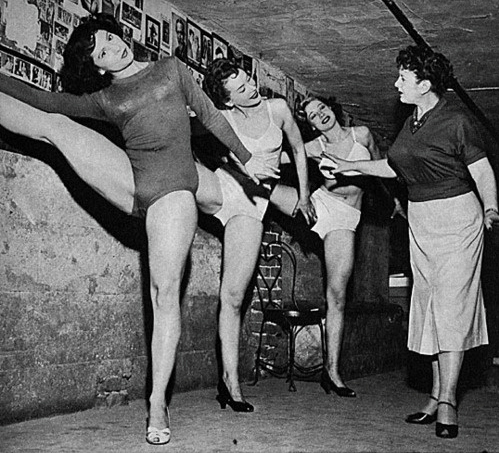
Lillian Hunt directing her girls (Courtesy of Pepper Aarvold)
In the large basement of the New Follies she continued leading her girls through acts, perfecting their unique talents. She loved her girls and they loved her because she genuinely cared about the art of burlesque and the talents strippers brought to it. Some of the biggest names thrived under her tutelage. She was one of a kind.
Lillian Hunt succumbed to cancer in 1964. The Follies was demolished in 1974. But for 20 years, every Friday night in the front row, a little old lady with her own big bosom and stripperish red-hair sat watching the new show of the week. Watching her girls. Proud of what they -- and she -- had accomplished.
Pepper Aarvold will be speaking at Los Angeles Visionaries Association where Zemeckis was a past speaker. Aarvold will be speaking about life backstage at the Follies on November 24th at 12:30 at Les Noces Du Figaro in downtown Los Angeles. http://www.lavatransforms.org.
Leslie Zemeckis, the author of Behind the Burly Q, the definitive history of burlesque, published by Skyhorse Publishing is finishing up her long-awaited biography on Lili St. Cyr. www.behindtheburlyq.com.

